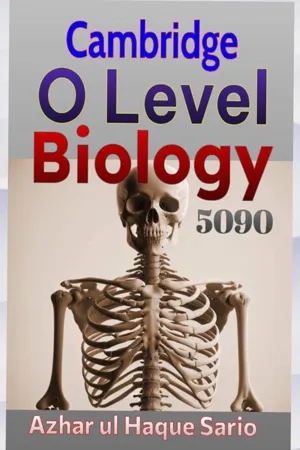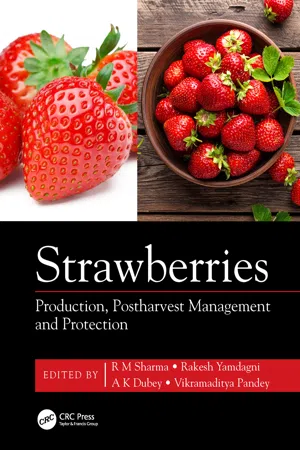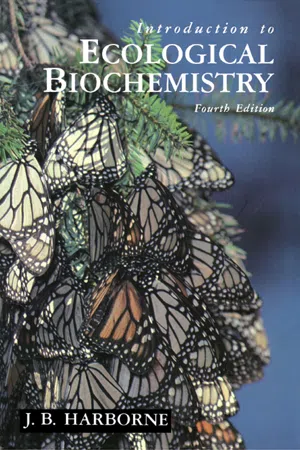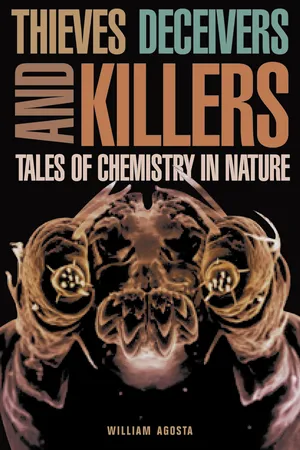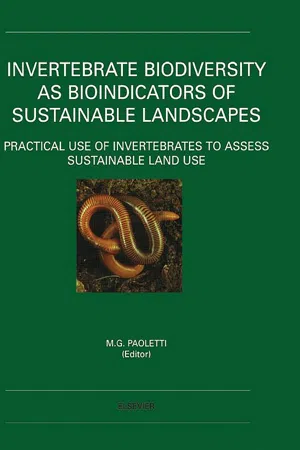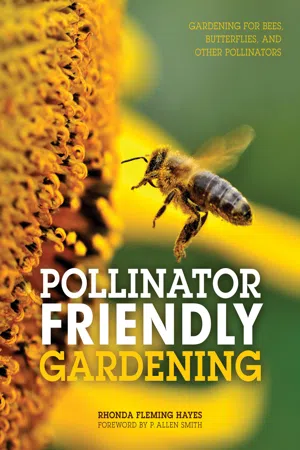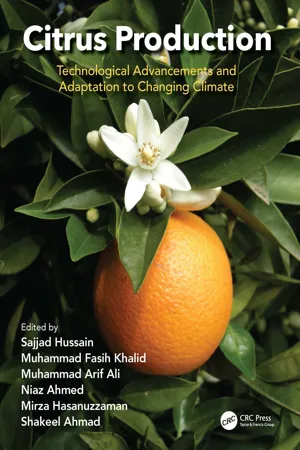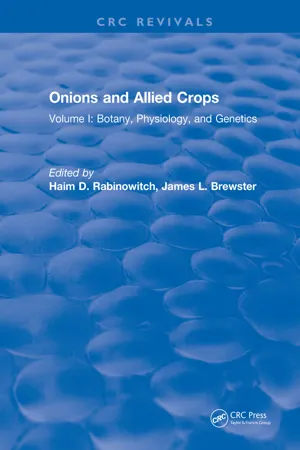Biological Sciences
Pollination
Pollination is the process by which pollen is transferred from the male reproductive organs of a flower to the female reproductive organs, leading to fertilization and the production of seeds. This transfer can occur through various agents such as wind, water, insects, birds, or other animals. Pollination is essential for the reproduction of flowering plants and the maintenance of biodiversity.
Written by Perlego with AI-assistance
Related key terms
10 Key excerpts on "Pollination"
- eBook - ePub
- Azhar ul Haque Sario, Azhar ul Haque Sario(Authors)
- 2023(Publication Date)
- tredition(Publisher)
Insect-pollinated flowers invest in attraction and interaction. They are like social butterflies, drawing in insects with their beauty and rewards. In contrast, windpollinated flowers are the strategists, utilizing the elements to their advantage, producing pollen en masse and relying on the whims of the wind for Pollination.This fascinating divergence in Pollination strategies shows us how diverse and adaptable life on Earth can be. It's a reminder of the intricate connections between different forms of life and how they co-evolve. The world of flowers, with their varied Pollination tactics, is a testament to the beauty and complexity of nature's designs.Pollination is an essential step in the life cycle of many flowering plants. It's about moving pollen grains from a plant's male parts to its female parts. This movement is crucial for plants to produce seeds and, eventually, new plants. Let's dive into this fascinating process in a straightforward and imaginative manner, and then explore its two primary forms: self-Pollination and cross-Pollination.Breaking Down PollinationBeginning with Blooms - The Role of Flowers: Flowers are the bright and often fragrant parts of plants that play a major role in Pollination. Their vibrant colors and scents are nature's way of attracting pollinators.Key Players - Pollen and Stigma: Pollen, a tiny, dusty substance, is produced by the male part of the flower known as the stamen. The female counterpart is the stigma, and it's the target spot for Pollination.Making the Move - How Pollination Happens:Pollination occurs when pollen grains travel from the stamen to the stigma. Various agents aid this process. Creatures like bees, butterflies, and other insects are frequent collaborators. They visit flowers for their sweet nectar and unknowingly transport pollen. Wind and water currents also play a part in spreading pollen.End Result - Seed Formation: Once Pollination is successful and the pollen is compatible with the stigma, fertilization occurs. This leads to seed creation, which can grow into new plants, continuing the cycle of life.Different Forms of Pollination 1. Self-Pollination - eBook - ePub
Strawberries
Production, Postharvest Management and Protection
- R M Sharma, Rakesh Yamdagni, A K Dubey, Vikramaditya Pandey(Authors)
- 2019(Publication Date)
- CRC Press(Publisher)
18 PollinationM.S. Khan , Poonam Srivastava, and R.M. Srivastava
CONTENTS 18.1 Flower Biology 18.2 Pollination Requirements 18.2.1 Pollen Production, Stigma Receptivity and Nectar Production 18.2.2 Modes of Pollination and Pollinizers 18.2.3 Pollinators 18.2.4 Floral Activity of Honey Bees 18.3 Managed Pollination Practices ReferencesPollination is an essential process in the lifecycle of most plants, and especially in higher plants such as fruit crops, as most of them require Pollination to ensure proper fruit setting. Pollination is the basis of genetic reconstitution and creation of variabilities for making improvement and evolving new varieties. Pollination is the process of transfer of pollen grains from anther on to the stigma of same flower (self-Pollination) or another flower of same plant species (cross-Pollination). Self-pollinated plant species can produce fruits but their number and quality are often improved when cross-pollinated. Cross-Pollination in crops has the potential to reduce loss and wastage of food so it could contribute to global food security (Klatt et al., 2014). To understand Pollination biology in a fruit crop such as strawberry, it is essential to have knowledge of various Pollination aspects such as floral biology, Pollination requirement, effective Pollination periods and the conditions, pollen germination, stigma receptivity, pollenizers, mode of Pollination and pollinators.18.1 Flower Biology
In strawberry, inflorescence is a modified stem and the flower cluster is a series of double-branches having one flower on each branch (Figure 18.1 - eBook - ePub
- J. B. Harborne(Author)
- 2014(Publication Date)
- Academic Press(Publisher)
When insects, bats and birds visit flowers to feed on (or collect for future consumption) the nectar and pollen, they usually pollinate the flowers in the process, so that both partners clearly benefit from this mutualistic association. There are three biochemical factors in this interrelationship; scent and colour of the flower and the nutritional value of nectar and pollen. As a pollinating animal approaches a flowering plant, one of the signals it receives is an olfactory one, from the flower scent. Animals live in a world of chemical communication, of pheromones, and they are undoubtedly able to detect the terpenes and other volatiles of flower odour at some distance. As the pollinator arrives near the plant, it also receives a visual signal, in the contrasting colour of the flower against the general green leafy background. As it alights on the flower, it may be drawn to the nectar by visual honey guides on the petal, derived from the differential distribution of pigments within the flower tissue. Finally, as it transfers the pollen from anther to stigma, it gains its reward, a nutritional one, based on the sugar and other constituents of nectar and pollen.In spite of the great amount written on Pollination ecology (e.g. Faegri and van der Pijl, 1979 ; Kevan and Baker, 1983 ; Proctor and Yeo, 1973 ; Real, 1983 ; Richards, 1978 ), biochemical aspects have rarely been explored in any detail. The present account is an attempt to gather most of the available information on this ecological topic. The subject of Pollination biology is vast, largely because this interaction between plant and animal is such a complex and subtle one and also because almost every group of plants has its own method of attracting pollinators and there are an enormous number of morphological adaptations to the various animal pollinators available to plants. Some brief introduction to the subject is needed here, particularly regarding the range of animal pollinators, the varying roles of animal visitors in relationship to flower pollinating processes and the phenomenon of flower constancy.To the casual observer in a flower garden in temperate latitudes, the Pollination of the flowers would largely appear during daylight hours to be the province of the very active bumble and hive bee, with some help being provided by a few smaller insects. This ignores, of course, the much wider range of active pollinators in tropical habitats: the humming birds, an enormous variety of large tropical butterflies, the wasps and the beetles. In addition, some flowers are only pollinated at night by bats or moths. Also, there is occasional Pollination by rodents, e.g. by mice and shrews in Protea spp. of South Africa and by bushrats in certain Banksia spp. in Australia. Finally, there are many smaller fauna, different kinds of flies and fleas, some of which are only apparent as pollinators to the most acute observer. The problem of determining which pollinator or pollinators are active on a particular plant species is difficult, requiring much time-consuming observation by the field naturalist. Some animals may visit flowers for other reasons than Pollination; also they may be able to ‘steal’ the nectar, without carrying out the Pollination necessary to the plant. Ants, for example, are well-known nectar thieves and are often so small that they sneak in and out of blossoms without touching the reproductive organs. They do, however, act as genuine pollinators in some cases. Hickman (1974) has shown that the small self-incompatible annual Polygonum cascadense is cross-pollinated by the ant Formica argentea . Reports of ant-pollinated plant species are, however, still few and far between (see Beattie, 1991 - eBook - ePub
Thieves, Deceivers, and Killers
Tales of Chemistry in Nature
- William Agosta(Author)
- 2009(Publication Date)
- Princeton University Press(Publisher)
Getting Pollinated
3
Just as immobility forces plants to make special arrangements for dispersing their seeds, it also complicates their reproduction. No less than animals, flowering plants depend on bringing sperm and egg together to propagate their species. Their inability to move about presents the problem of how to bring these reproductive cells together. A plant’s sperm cells are carried in pollen grains that ripen on parts of a flower called anthers. Pollen must be transferred to another part of a flower, the stigma, before sperm and egg can come together. In some cases, a single plant or even a single flower might pollinate itself, that is, move pollen from an anther of one flower to the stigma of the same or a nearby flower. This is possible at times because individual plants of some species bear both male and female flowers or a single flower may afford both sexes. However, for most plant species where it is possible, self-Pollination—or inbreeding—is not a realistic option, as it does not lead to fertilization or at best furnishes inferior progeny. To set good seed, most plant species avoid inbreeding and require pollen from a different individual.As a result, plants have a quite different focus to their reproductive activities from that of most familiar animals. From butterflies to bowerbirds, animals pour great energy into sexual rituals that have one primary purpose: A male seeks to attract a receptive female and convince her of his superiority over competing males. To do this, perhaps he brings her a gift, wins a fight, or builds her a nest. By one means or another, he attempts to prove his excellence so the female will permit him to father her offspring. This face-to-face evaluation by the opposite sex has no place in the plant world. Here, successful reproduction is possible only if suitable pollen is somehow delivered from one plant to another, and so plants devote their energy to securing some third party’s assistance in carrying out this task. Unfortunately, outside pollinators are not always easily obtained. For nearly half the species biologists have investigated, third-party assistance is the limiting factor in natural reproductive success. For these species, the critical issue is not the weather, predation by seed-eaters, or the fertility of the soil, but simply whether a sufficient number of pollinators appear at the right time. Without pollinators, there will be no next generation. - eBook - ePub
Invertebrate Biodiversity as Bioindicators of Sustainable Landscapes
Practical Use of Invertebrates to Assess Sustainable Land Use
- Maurizio G. Paoletti(Author)
- 2012(Publication Date)
- Elsevier Science(Publisher)
Throughout this chapter, the roles of other anthophiles (flower visitors) in agricultural and natural ecosystems, particularly with regard to pest management and biocontrol are considered as well. However, before addressing pollinators and other anthophiles as bioindicators, some background may be useful. Particularly important in recognizing the value of anthophiles as bioindicators, is the appreciation of their roles in sustainable global productivity and the sorts of natural and anthropogenic factors that affect their populations. Thus, the first part of this chapter reviews the main issues of Pollination and pollinator biology that impinge on their roles as bioindicators.2 Pollination, pollinators, and anthophiles
Pollination is simply the transfer of pollen from the anther of one flower to the stigma of another or the same flower. After production of the sexual organs and associated structures, Pollination is the first step in the reproductive process of higher plants. It is achieved by biotic and abiotic means. Abiotic Pollination occurs by wind, water or gravity. Biotic Pollination is effected by animals. There is an entire and specialized vocabulary concerned with plant breeding systems (Richards, 1986 ) and Pollination mechanisms (Faegri and van der Pijl, 1979 ) which need not be invoked in this review. The most important concepts and terminology in reference to agriculture are presented in Roubik (1995) , and the book by Free (1993) is an encyclopedic treatise on crop Pollination by insects.Anthophiles or flower visitors, are animals which feed at flowers. They may seek pollen, nectar, oil or floral tissue to satisfy their nutritional needs (see Kevan and Baker, 1983 , 1998 ). Pollen provides protein, lipid, carbohydrate, vitamins and minerals in various amounts depending on the plant species. Nectar is mostly a sugary solution and provides energy for locomotion, mostly flight. It also contains other compounds, some probably involved in nutrition, in trace amounts. Oil is provided by some specialized flowers as the reward for their specialized pollinators. Floral tissue is thought to have been the original resource sought by primitive, herbivorous anthophiles, the beetles (Coleoptera) (Bernhardt and Thien, 1987 ). Pollinators are anthophiles which bring about Pollination. Not all anthophiles are effective pollinators; some are floral larcenists that remove the resources sought by pollinators or eat pollen needed in abiotic Pollination (Inouye, 1980 ); others may be innocuous and merely rest in flowers or glean residual resources after Pollination is over. Although pollinators are vital to plant reproduction, non-pollinating (or poorly pollinating) anthophiles may also be important in ecosystemic function. For example, many insects that are useful in biocontrol of pests require florally derived food to mate, find hosts, oviposit and complete their life cycles (Jervis et al., 1993 ; Ruppert, 1993 ). There are also anthophiles that use floral sites for capturing prey (Kevan and Baker, 1983 ; Greco and Kevan, 1994 - eBook - ePub
Pollinator Friendly Gardening
Gardening for Bees, Butterflies, and Other Pollinators
- Rhonda Fleming Hayes(Author)
- 2016(Publication Date)
- Voyageur Press(Publisher)
Plants that use the wind to reproduce throw out huge quantities of lightweight pollen grains (the ones most responsible for all of those miserable symptoms) that fly through the breeze. Many trees, such as willow, birch, walnut, conifers, and even grasses rely on this system, one that takes advantage of an abundant natural resource without expending energy on producing conspicuous flowers to entice insects. Their flowers don’t produce nectar and have little to no fragrance. Their stamens, like those on birch catkins, are exposed to make it easier to catch pollen passing by. With this scattered shotgun approach, though, enormous amounts of pollen miss their mark and are wasted in the process.Pollen sticks to this long-horned bee’s hairy body. It’s then transferred as the bee moves from flower to flower.Insect Pollination, on the other hand, is highly efficient and accurate. Pollen grains are held on the anthers at the center of the flower. When bees, butterflies, and other pollinators visit the flowers looking for nectar, they brush against the flower’s anthers, catching the pollen grains on their bodies. Bees also seek their share of the pollen, packing it into specialized structures on their hairy bodies to transport back to their hive. As pollinators move from flower to flower, some of the pollen falls off and sticks to the stigma, the prominent female flower part that serves as the entrance to the flower’s ovaries. The pollen grain is made up of two cells: one forms a pollen tube which then directs the other generative cell taking the pollen down into the depths of the flower where it fertilizes the waiting egg. Once fertilized, this enables the plant to make seeds.Within this process there are different types of Pollination. In self-Pollination, pollen moves within one flower or between flowers of the same plant. These plants are described as self-fertile. Cross-Pollination occurs when pollen moves from one plant of the same species to another. Self-fertile plants may indeed produce flowers and fruit but lack the genetic diversity that comes from repeated cross-Pollination. This genetic diversity helps plants adapt to changing conditions, pests and disease, and other stresses, a quality that becomes more and more important with climate change.THE POLLINATORS
HONEYBEES
Lemon chess pie with blackberry compote, courtesy of cross-Pollination.Honeybees are native to just about everywhere other than North America—Europe, Africa, the Middle East, and Central Asia. The European colonists introduced them to the New World in the early 17th century, and since then they have made themselves at home and become a vital part of our agriculture—both for honey production and crop Pollination. They vary from gold to brown to black. Most importantly, though, they all are fuzzy, which is ideal for collecting loads of pollen that they store in their pollen basket, a specialized body part called a corbicula - eBook - ePub
- Richard Karban(Author)
- 2015(Publication Date)
- University of Chicago Press(Publisher)
Polemonium viscosum (Galen 1996, 1999). Most Pollination biologists agree that pollinators have caused floral traits to diverge, and that particular traits (syndromes) are associated with particular groups of pollinators (Fenster et al. 2004). Plants that are pollinated by animals have radiated and are currently much more speciose than those pollinated by abiotic vectors (Dodd et al. 1999). Both as agents of selection and as agents of gene flow, pollinators will be most effective at causing floral divergence and plant speciation if they are specialized to visit only certain flowers (flower constancy) (Waser 2001). What remains unclear is whether Pollination systems are sufficiently specialized to lead to ethological isolation and speciation (Waser et al. 1996, Waser 2001).7.1.5 Communication and postdispersal pollen fate
Most work on the interactions between plants and pollinators concerns the movement of pollen from anthers to stigmas, a bias that has been reflected in this chapter. However, to be represented in the next generation, a pollen grain must germinate on a stigma, grow a pollen tube that competes with other pollen grains in a race to reach an ovule, and fertilize the ovule. This fertilized embryo then competes with others for maternal resources. During this process, the maternal plant can provide signals that help to direct the growth of the pollen tube and may evaluate the pollen or developing embryo and provision it richly, or not at all.Interactions between pollen grains on the stigma can affect pollen success. Proteins and lipids on the pollen coat recognize the stigma and facilitate adhesion to this surface (Chapman and Goring 2010, Chae and Lord 2011). Following adhesion, a protein secreted by the stigma interacts with pollen receptor kinases to promote pollen tube growth (Tang et al. 2004). Pollen germination rates increased as the density of pollen grains increased on stigmas of numerous species (Brewbaker and Majumder 1961). This situation involving high pollen grain density has been interpreted as providing increased pollen competition. Females may also delay stigma receptivity, which should increase pollen competition and maternal fitness (Lankinen and Kiboi 2007, Madjidian et al. 2012). Females can also increase competition among potential sires by lengthening the pistil and manipulating its pH (Skogsmyr and Lankinen 2002). - eBook - ePub
Citrus Production
Technological Advancements and Adaptation to Changing Climate
- Sajjad Hussain, Muhammad Fasih Khalid, Muhammad Arif Ali, Niaz Ahmed, Mirza Hasanuzzaman, Shakeel Ahmad, Sajjad Hussain, Muhammad Fasih Khalid, Muhammad Arif Ali, Niaz Ahmed, Mirza Hasanuzzaman, Shakeel Ahmad(Authors)
- 2022(Publication Date)
- CRC Press(Publisher)
20 Pollination in CitrusAsif Sajjad and Waseem AkramThe Islamia University of BahawalpurWali MuhammadGovernment of PunjabMunir AhmadArid Agriculture University RawalpindiAmmad AhmadThe Islamia University of BahawalpurDOI: 10.1201/9781003119852-20Contents
- 20.1 Introduction
- 20.2 Mode of Citrus Pollination
- 20.3 Floral Phenology
- 20.4 Citrus Flower as the Nectar and Pollen Source
- 20.5 Diversity of Citrus Pollinators
- 20.6 Pollination and Postharvest
- 20.7 Conclusion
- References
20.1 Introduction
Insect pollinators are the vectors that transfer pollen grains from the anther to the stigma, enabling fertilization and seed production (Potts et al. 2016 ; Das et al. 2018 ). Pollination is an ecosystem service that enhances crop production and ensures sustainability in human life (Klein et al. 2007 ; Potts et al. 2016 ). One-third of the agricultural plants rely on insect pollinators for their reproduction and increased fruit set (Greenleaf and Kremen, 2006 ). Around, 90% of wild flowering plant species rely on insect pollinators. Wild plants are essential for the proper functioning of an ecosystem as they supply food, habitat, and other resources to a variety of different species (IPBES, 2016).Among pollinators, bees play a key role by visiting more than 9% of the world’s leading crop plants (Klein et al. 2007 ). Agricultural intensification and monocropping have led to habitat loss for many insect pollinators (Krebs et al. 1999 ; Tscharntke et al. 2005 ). A serious concern for the global decline in pollinators can be sensed which may affect seed or fruit set influencing its yield (Rathcke, 1983 ; Rodrigo and Herrero, 1996 ; Partap et al. 2000 ; Biesmeijer et al. 2006 ). The decline in pollinator species also causes a decline in its associated plant species (Biesmeijer et al. 2006 ). Therefore, insect Pollination is now considered an endangered ecosystem service (Corbet, 1991 ; Williams, 1994 ; Ghazoul, 2005 ). The crisis of pollinators threatens local and global food security and ruins human life as well. Thus, studies on crop Pollination are inevitable due to the perceived threat that it invites (Ghazoul, 2005 ; Steffan-Dewenter et al. 2005 ). However, a detailed preview of Pollination studies is redundant or incomplete (Klein et al. 2007 ). Therefore, understanding the Pollination needs of various cultivated plants is a requirement to understand their dependence on pollinators (Klein et al. 2007 - eBook - ePub
Onions and Allied Crops
Volume I: Botany, Physiology, and Genetics
- H.D. Rabinowitch(Author)
- 2018(Publication Date)
- CRC Press(Publisher)
Chapter 6 Pollination Biology Lesley Currah Table of Contents I. Introduction II. The Onion Flower III. The Insect Pollinators IV. Pollination Investigations and Onion Breeding V. Pollinator Behavior on Onion Seed Crops in the Field VI. Pollination Biology and the Onion Breeding System Acknowledgments References I. Introduction Pollination biology is the study of the ways in which plants achieve Pollination and the influence of the events of Pollination on subsequent fertilization, seed production, and the progeny produced. Topics which it involves include plant and flower morphology, phenology (i.e., the timing of flowering and of the progress of flowering processes within the flower), the influences of weather and microclimate on flowering, and the interaction of these factors with the insect pollinators themselves. In insect-pollinated crops such as the onion, the kinds of pollinators attracted to the crop and their behavior are also studied. Pollination biology is therefore of considerable interest, to breeders and seed producers in particular. Much published work on the topic is of a descriptive nature, but a substantial body of experimental technique and data is being built up. The topic in onion has been well reviewed previously by Free, 1 McGregor, 2 and Waller. 3 The onion (Allium cepa L.), a plant only found today under domestication, is involved in a triangle of interactions involving two other vital components for its continued existence. Man, as the grower of the crop, maintains the onion as a valued food, and as seed production manager, selects from the population those plants which are to reproduce. Later, the farmer or seedsman also takes responsibility for the storage and distribution of the seed. The onion follows a growth cycle which is normally biennial: the edible bulb is produced after one season's growth, and this is the chief commercially saleable product - eBook - ePub
Plant Invasions
The Role of Biotic Interactions
- Anna Traveset, David M. Richardson, Anna Traveset, David M Richardson(Authors)
- 2020(Publication Date)
- CAB International(Publisher)
et al., 2011). Therefore, Pollination interactions are expected to play a key role in the naturalization—invasion processes of most plants introduced to new areas. Such interactions are determined both by the traits of the species involved in them and by environmental factors (Morales and Aizen, 2006), influencing both the quantitative and the qualitative components of the Pollination process (Aizen and Harder, 2007). Understanding the role of Pollination interactions in the reproductive success of non-native species in their new areas can provide new insights for invasion management; specifically, about the potential of avoiding or disrupting Pollination interactions as prevention, control or eradication measures.In this chapter, we review the increasing knowledge on the relevance of Pollination interactions promoting or constraining plant invasions in different ecosystems across the globe, with the goal of assessing the following:1.To what extent do invasive plants depend on pollinators for their reproduction and when does such dependence influence invasion?2.Which are the species traits and the main functional groups of the resident pollinators visiting invasive plants?3.How do environmental factors affect Pollination interactions in plant invasions?4.What are the implications of plant—pollinator interactions for the management of plant invasions?4.2 To What Extent Do Invasive Plants Depend on Pollinators for Their Reproduction and When Does Such Dependence Influence Invasion?The extent to which Pollination interactions are relevant in plant invasions will depend on different traits of the introduced plant: i) its reliance on sexual reproduction; ii) its degree of selfcompatibility; iii) its dependence on pollinators for pollen movement from anthers to stigmas; and iv) its plasticity for the above-mentioned traits. Then, if introduced plants rely on sexual reproduction and require pollinators for pollen movement, invasion success may be contingent on e) the plant’s degree of ecological specialization to pollinator species or functional groups and f) its plasticity for this trait.
Learn about this page
Index pages curate the most relevant extracts from our library of academic textbooks. They’ve been created using an in-house natural language model (NLM), each adding context and meaning to key research topics.
